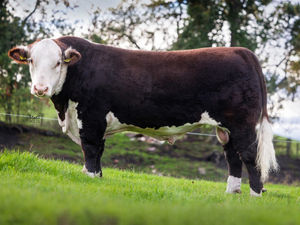Making the most of oilseed rape opportunities in Shropshire
Despite continuing to grow it one year in every three or four, Rob Morgan and his agronomist brother, Dai are pushing 5t/ha from the 25ha or so of winter rape they grow each year on their family’s Home Farm, Acton Burnell on the northern edge of the Shropshire Hills Area of Outstanding Natural Beauty.
In an approach that combines traditional power harrow drilling and the pioneering use of low biomass hybrids with the semi-dwarf character, they are currently achieving gross margins comfortably over £1000/ha. This ensures the crop fully justifies its place financially as well as rotationally.
Over the past 20 years the business has developed from a typically mixed south Shropshire farm with a dairy herd as well as beef, sheep and cropping to an almost entirely arable holding with a small amount of grass. An indoor straw-based enterprise rearing 50-75 in-calf heifers a year for a local dairy herd makes use of the original livestock barns while providing a useful supply of farmyard manure for the crops.
While most growers have been extending their rotations, the Morgans have been concentrating theirs. In the past grass leys for the livestock as well as maize provided clean breaks that allowed the farm to grow a variety of different seed crops. But it no longer has this ability. Nor, quite frankly, does Rob have the time for any unnecessary complexity with all his local contracting commitments. So the family needs a system that’s as easy to manage as it can be as well as consistently profitable.
“It’s difficult to find any cereal break that comes anywhere near winter rape in margin-earning,” Rob Morgan explained. “Pulses can never do this and decent oat contracts are a bit like hen’s teeth these days. So we grow rape between every two or three winter cereals.
“Contracting allows us to maintain a level of machinery investment we simply couldn’t justify on our acreage alone. However our cultivation equipment needs to be equally at home with both cereals and OSR. Importantly too, although we can hire in extra draught power for subsoiling, our main kit has to be compatible with my single 130 hp tractor. Our whole regime has to fit around my contracting obligations as well as our own crop needs too.”
OSR establishment at Home Farm is essentially a two-pass system. Seedbed preparation is preceded with a light-discing immediately after cereal combining for stale seedbed control of brome and volunteers. Thankfully, black-grass is not yet a problem.
As soon as the weed growth has been sprayed off, biosolids are contract-applied at around 20t/ha and incorporated with the main Sumo Trio cultivation which combines shattering at depth with good surface soil movement.
The ground is then drilled without delay with a 3m Kverneland Accord i-drill. Its disc coulters give particularly even sowing and good depth control immediately behind the power harrow. Cambridge rolling within the day, wherever possible, ensures the firm, fine seedbeds Rob and Dai have always prioritised.
“We take great care to conserve soil moisture in all our work,” stressed Rob. “Our post-harvest discing is deliberately as light as it can be to achieve a weed chit without drying the ground. We then drill directly after incorporating the biosolids, which we’ve used for four years now. And we roll right after drilling for extra consolidation.
“This recipe allows us to get consistently good establishment from conventional varieties at 55 seeds/m2 and the low biomass hybrids we prefer at 35 seeds/m2, both sown after the end of August as a rule.”
Apart from allowing sufficient time for a decent stale seedbed, BCW Agriculture agronomist, Dai Morgan finds that drilling in September always seems to give better results, even with semi-dwarf varieties that have, in the past at least, been rather slower to take-off than many.
“I’ve never seen really heavy rape yields from early drilling,” he observed. “People often feel better about their crops in October when they’ve drilled them in August. But it’s what ends up in the tank that matters and our medium loam soils are definitely best sown after the August bank holiday and often well into September.
“Holding-back on sowing for a stale seedbed is also important in allowing us to minimise weed competition during early establishment – especially with the semi-dwarf varieties we’ve grown for a number of years – and to do the best rotational cleaning job.
“It’s valuable too in reducing the infection period for clubroot which is becoming a bit of an issue in some of our fields and needs watching closely.
“Finally, we really don’t get a second chance with rape establishment. So we need to get things spot-on and that’s not always easy when Rob is so busy with contract combining.
“Hand-on-heart, we’ve yet to have a crop failure with our system,” said Dai. “Yes, we could shave £25-50/ha off establishment costs by mounting a seeder on the Sumo. But then we’d need to increase seed rates to make-up for less even establishment which could, in turn, put the pressure on our canopy management and hit yields. It’s not a risk we’re prepared to take.”
The fact that the Morgans are continuing to do so well with winter rape in a rotation many might consider a little on the tight side these days is testament to the care and attention they put into every aspect of the crop.
In this their decision to concentrate on semi-dwarf varieties almost from their first availability in the UK has been significant. Following the 5.02t/ha they achieved from a 1ha trial plot last season, their preferred variety this season is DK Secret which they are growing alongside sister low biomass hybrid, DK Severyni and a small amount of conventional rape.
“Even though semi-dwarfs haven’t yet matched standard height winter rapes in their official trial performance, they’ve always done us well,” pointed out Rob. “Plus, they’re a lot easier to look after; we can fertilise them well into flowering with our spreader; and we’ve never had them lodge on our relatively high fertility ground.
“Now we have varieties that do a good 5t/ha on our ground, get away quicker in the autumn and have some of the best diseases resistance ratings in the business, we’re even more positive about them.”
Early OSR management at Home Farm is all about the most effective weed control. A pre-em combination of dimethenamid-p, metazachlor and quinmerac gives strong activity against broadleaves in the Morgans’ fine firm seedbeds. This is accompanied by clomazone which deals very effectively with any hedge mustard issues.
A follow-up application of dimethenamid-p, metazachlor and quinmerac in mid-October tops-up the pre-em residuality while the low biomass crop is still close to the ground, with a graminicide to knock cereal volunteers on the head. Propyzamide has yet to prove necessary given the farms ‘favourable’ black-grass situation.
To protect against both phoma and light leaf spot without any PGR effect, Dai specifies a late autumn combination of penthiopyrad and picoxystrobin designed to carry the crop through to the stem extension spray of tebuconazole and prochloraz.
A strobilurin is also included with tebuconazole in an early flowering spray to bolster the crop’s light leaf spot defences, give good early sclerotinia protection and take advantage of its physiological effect in the absence of significant disease. This enables a low dose of boscalid at petal drop to complete the disease management programme.
“Despite good soil fertility levels, we certainly don’t need any conventional plant growth regulation with the semi-dwarfs, but we are looking for some positive canopy management in our programme as well the valuable physiological effect we get from strobs,” noted Dai.
“We often don’t need much in the way of early N either,” Rob added. “Alongside the variable rate P & K we apply each spring to our fully mapped fields, we use poly-sulphate to get all our sulphur on without having to add nitrogen. We generally apply around 185 kg/ha as soon as we can travel in the spring, giving it the time it needs to work. At 48% sulphate and 14% potash with extra magnesium it’s good value.
“Overall, we reckon around 220-240 kg/ha of nitrogen is about right for our crops. Our first split in the spring is usually only around 35kg/ha. With the nitrogen from the sewage sludge this is all we need. We then add a further 100kg/ha at stem extension and keep 65kg/ha back as late as we can to feed the seed rather than the canopy.
“The semi-dwarfs really help here, allowing us to hold-off on spreading our final nitrogen a lot longer than we ever can with standard height varieties.
“I have to say pre-harvest spraying is much less of a problem with these types too,” he continued. “They’re far quicker to harvest. Their height, pod shatter resistance and the pod sticker we always use as a belt and braces mean we get all their yield in the tank.
“Another advantage is stubbles that are altogether less demanding – and time-consuming – to deal with. We really appreciate this with the scale of the autumn workload our harvesting and drilling contracts bring.
“Reliably good performance with as little worry as possible is what we need from our OSR. I’m sure we have plenty of room for improvement as we target a consistent 5t/ha-plus. But what we can’t afford is any unnecessary extra equipment investment. So it’s really a matter of finding ways of continuing to making more from what we’ve got.”





